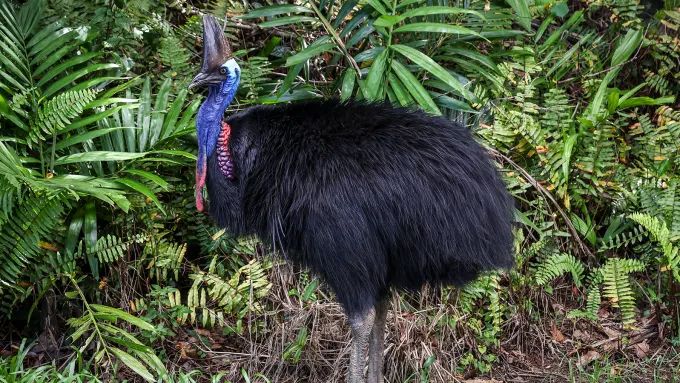The cassowary, often labeled the world’s most dangerous bird due to its sharp, dagger-like toes, may have been one of the first birds raised by humansthousands of years before chickens were domesticated.
A recent study analyzing over 1,000 fossilized eggshell fragments suggests that early humans in New Guinea collected cassowary eggs and raised the chicks to adulthood as early as 18,000 years ago.
“This behavior that we are seeing is coming thousands of years before the domestication of the chicken,” said Kristina Douglass, lead author of the study and an anthropology professor at Penn State University. Despite the cassowary’s aggressive nature, it imprints easily, becoming attached to the first thing it sees after hatching, which made it relatively easy to raise.
The study, which examined fossilized eggshells from two rock shelters in New Guinea, found that most shells were harvested during the late stages of incubation, indicating that humans may have deliberately allowed the chicks to hatch. Using carbon dating, researchers determined that the eggshells ranged in age from 18,000 to 6,000 years old—predating the domestication of chickens, which is believed to have occurred no earlier than 9,500 years ago.
Cassowaries are native to northern Queensland, Australia, and New Guinea, where their feathers and bones are still used for ceremonial wear, and their meat is considered a delicacy.
The study suggests that ancient humans most likely reared the dwarf cassowary, the smallest species, which weighs around 20 kilograms (44 pounds). While cassowaries can be dangerous one killed a man in Florida in 2019 their tendency to imprint made them easier to raise.
To determine the timing of egg harvesting, researchers studied the eggshells of modern birds like turkeys, emus, and ostriches. As chicks develop, they absorb calcium from the eggshell, altering its interior structure.
By creating high-resolution 3D images of these changes, the team built a model that helped them analyze the fossilized cassowary eggs. The results showed that most eggs were harvested late in incubation, when embryos had fully developed limbs, beaks, and feathers.
This finding suggests humans intentionally collected eggs close to hatching. While consuming eggs with fully formed embryos is considered a delicacy in some parts of the world, Douglass and her team believe that many of these chicks were allowed to hatch and raised to adulthood. This behavior indicates a level of animal husbandry that predates the domestication of chickens and other birds.
Raising cassowaries would have required significant care and attention, as the birds’ imprinting behavior would have created a bond with their human caretakers, making them easier to manage despite their aggressive nature. This suggests that ancient humans understood and exploited this behavior to their advantage.
The discovery of fossilized cassowary eggshells in New Guinea offers new insights into the complex relationship between humans and animals in prehistoric times. Long before chickens were domesticated, humans may have raised cassowaries for their feathers, bones, and meat, marking a previously unknown chapter in the history of animal domestication.

